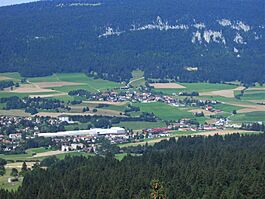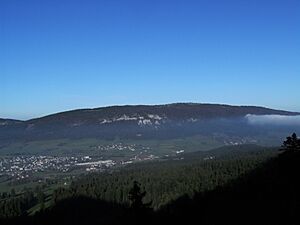Loveresse facts for kids
Quick facts for kids
Loveresse
|
||
|---|---|---|

Loveresse village (center) and surrounding municipalities
|
||
|
||
| Country | Switzerland | |
| Canton | Bern | |
| District | Jura bernois | |
| Area | ||
| • Total | 4.69 km2 (1.81 sq mi) | |
| Elevation | 761 m (2,497 ft) | |
| Population
(Dec 2020 )
|
||
| • Total | 349 | |
| • Density | 74.41/km2 (192.7/sq mi) | |
| Postal code |
2732
|
|
| Surrounded by | Reconvilier, Saules, Souboz, Pontenet, Malleray | |
Loveresse is a small town, also called a municipality, located in Switzerland. It's found in the Jura bernois area, which is part of the canton of Bern. People in Loveresse mostly speak French, as it's in the French-speaking part of the Bernese Jura.
Contents
History of Loveresse
Loveresse was first mentioned in old writings around 1148. Back then, it was called de Loveresce. Later, in 1225, it was known as Loverasse.
Early Land Ownership
In the 1100s, two important religious groups owned land in Loveresse. These were Bellelay Abbey and the Moutier-Grandval Abbey. By the late 1200s, Bellelay Abbey owned most of the land in the village.
In 1404, the Prince-Bishop of Basel gave special rights to Loveresse. This was done to encourage more people to move there.
Religious Changes
The village church was part of the Tavannes-Chaindon area. When this area changed to the Protestant faith, Loveresse also became Protestant. It stayed part of that church group until 1928. Then, it joined the Reconvilier church group.
French Rule and Swiss Return
Later, the village was owned by the leader of Moutier-Grandval. In 1797, France won a war and Loveresse became part of France. It was first in the Mont-Terrible area, then in Haut-Rhin. After Napoleon lost power, Loveresse became part of the Canton of Bern in Switzerland in 1815.
Local Industries and Hospice
In the late 1800s, several companies that made watches started in Loveresse. However, these businesses did not survive the worldwide Great Depression in the 1930s.
In 1906, the Canton of Bern bought a special building in the Vallée de Tavannes. It was first used as a boarding school for girls. Later, in 1975, it became a clinic for the Bellelay region. After 1987, it was used as a school for farming.
Geography and Location
Loveresse covers an area of about 4.64 square kilometers (1.79 square miles). A large part of this land is used for farming, and another big part is covered by forests.
Land Use
About 46.6% of Loveresse's land is used for farming. This includes growing crops and pastures for animals. Forests cover about 48.1% of the area. The rest of the land, about 5.5%, has buildings or roads. A very small part is rivers or lakes.
Natural Features
The municipality is located on the southern side of Moron Hill. This hill is in a valley called the Vallée de Tavannes. All the water in Loveresse comes from flowing rivers and streams.
Administrative Changes
Loveresse used to be part of the Moutier district. But on January 1, 2010, it joined a new administrative area called Arrondissement administratif Jura bernois.
Loveresse's Coat of Arms
The coat of arms for Loveresse has a special design. It shows a red background with a silver bar across it. On this silver bar, there is a red rose with green leaves and a yellow center.
People of Loveresse (Demographics)
Loveresse has a population of about 315 people. Most people in Loveresse speak French as their main language. About 86.2% of the population speaks French. The second most common language is German, spoken by about 12.9% of the people.
Population Makeup
As of 2008, about 48.4% of the people in Loveresse were male, and 51.6% were female. Most of the people living there are Swiss citizens. About 28.5% of the people were born in Loveresse itself.
Age Groups
In 2011, children and teenagers (ages 0-19) made up about 20.6% of the population. Adults (ages 20-64) were the largest group, making up 59.7%. Seniors (over 64 years old) made up 19.7% of the population.
Economy and Jobs
In 2011, Loveresse had a very low unemployment rate of 0.83%. This means almost everyone who wanted a job had one.
Types of Jobs
In 2008, there were 160 people working in Loveresse. Jobs are divided into three main types:
- Primary sector: This includes jobs like farming. About 23 people worked in this area.
- Secondary sector: This includes jobs in manufacturing, like making things. About 51 people worked here, mostly in factories.
- Tertiary sector: This includes jobs in services, like shops, hotels, and healthcare. About 86 people worked in this sector.
Many people who live in Loveresse also work there. However, more people travel out of Loveresse for work than those who come in. Most people use a private car to get to work.
Religion in Loveresse
Based on information from 2000, about 51.1% of the people in Loveresse belonged to the Swiss Reformed Church. Another 17.1% were Roman Catholic. Some people belonged to other Christian churches, and about 9.91% did not belong to any church.
Education System
In Loveresse, many people have finished their high school education. About 13.6% have gone on to higher education, like university.
School Structure
The school system in the Canton of Bern, where Loveresse is located, has a specific structure:
- One year of optional Kindergarten.
- Six years of Primary school.
- Three years of mandatory lower Secondary school. In this stage, students are grouped by their abilities.
After lower Secondary school, students can choose to continue their education or start an apprenticeship (learning a trade on the job).
In the 2011–12 school year, there was one primary class in Loveresse with 21 students. Most students spoke the classroom language as their first language.
Student Movement
In 2000, most students living in Loveresse also went to school there. However, some students from Loveresse went to schools in other towns.
See also
 In Spanish: Loveresse para niños
In Spanish: Loveresse para niños





